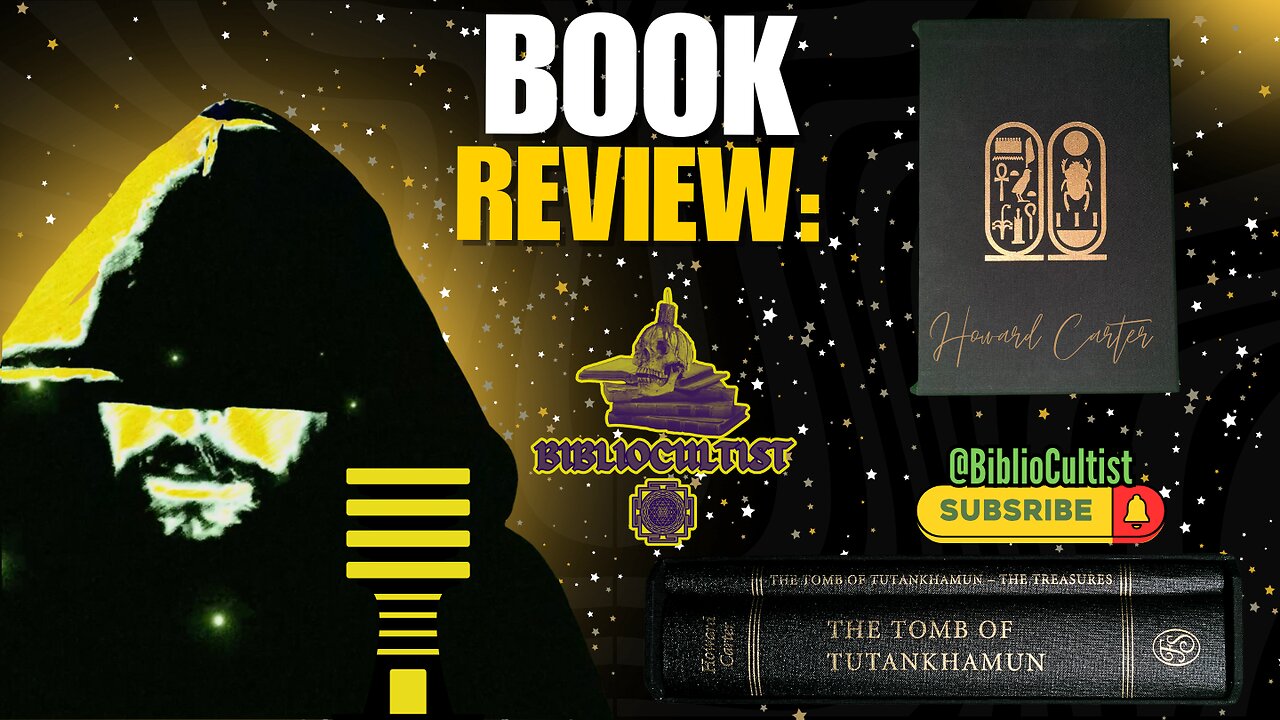Premium Only Content

Howard Carter's Memoirs: Unearthing Tutankhamun's Tomb
In this 'spoiler free' #bookreview/#bookrecommendation, I explore Howard Carter's 'The Tomb of Tutankhamun', which documents the groundbreaking discovery of the boy king's tomb in the 1920s. The video highlights how the book captures the excitement and intrigue surrounding this archaeological find, fueling public interest in Egyptian mysteries and the 'curse of the pharaohs' myth. I delve into Carter's detailed accounts of the painstaking excavation process and efforts to preserve the tomb's priceless artifacts. The review also notes how Carter underscores the personal, intimate nature of Tutankhamun's tomb compared to more religious, monumental burials, offering insights into ancient Egyptian funerary practices and beliefs about the afterlife.
*all music and content copyright BiblioCultist.com*
#booktube #books #HowardCarter #TheTombOfTutankhamun #Tutankhamun #KingTut #archaeology #Egypt #ancientEgypt #curseof thepharaohs #funerarypractices #afterlife #biblio #cultist #cult
**SHOW NOTES**
1. Howard Carter (1874–1939) was a British archaeologist and Egyptologist best known for discovering the tomb of Tutankhamun in 1922 in the Valley of the Kings, Egypt. This groundbreaking find, funded by Lord Carnarvon, revealed an intact burial chamber filled with treasures, sparking global fascination with ancient Egypt. Carter's meticulous excavation and documentation set new standards in archaeology. Despite limited formal education, his passion and expertise made him one of the most celebrated figures in Egyptology
2. The Pharaoh's Curse, popularized in the 1920s, is the belief that anyone who disturbs the tomb of an ancient Egyptian pharaoh, particularly Tutankhamun, would suffer misfortune, illness, or death. This myth gained widespread attention after the discovery of Tutankhamun's tomb by Howard Carter in 1922, when several members of the expedition and associated individuals died under mysterious circumstances. While many deaths were later attributed to natural causes or coincidences, the media sensationalized the idea of a curse, fueled by the tomb's eerie inscriptions and the public's fascination with ancient Egypt.
3. Akhenaten (r. 1353–1336 BCE) was an ancient Egyptian pharaoh of the 18th Dynasty, known for his radical religious revolution. He abandoned Egypt's traditional polytheistic worship, particularly of Amun-Ra, and elevated Aten, the sun disk, as the supreme deity. Akhenaten declared Aten the sole god, centralizing worship and building a new capital, Akhetaten (modern Amarna), dedicated to Aten.
4. The Book of the Dead is an ancient Egyptian funerary text, used from around 1550 BCE to 50 BCE, containing spells, prayers, and instructions to guide the deceased through the afterlife. It was written on papyrus and placed in tombs, serving as a liturgical tool to ensure safe passage, protection from demons, and a favorable judgment by Osiris in the Hall of Ma'at. The texts varied for each individual, reflecting personal beliefs and status, and were often accompanied by illustrations.
5. The Cult of Osiris centered on the god Osiris, who, after being murdered and resurrected, became the ruler of the underworld and judge of the dead. According to the myth, Osiris offered salvation to all who worshipped him, ensuring their safe passage to the afterlife. In the Hall of Ma'at, the deceased's heart was weighed against the feather of truth; if deemed righteous, they were granted eternal life in the Field of Reeds. This salvific promise made Osiris a central figure in Egyptian religion, symbolizing resurrection, justice, and hope for immortality.
6. The Djed (𓊽) is an ancient Egyptian symbol representing stability, endurance, and the backbone of the god Osiris. Often depicted as a pillar with horizontal lines, it was used as a protective amulet and played a key role in rituals, symbolizing resurrection and eternal life. The Djed also connected to agricultural cycles, embodying renewal and strength in both the physical and spiritual realms.
7. The scapular is a Christian devotional garment, often consisting of two small pieces of cloth connected by strings and worn over the shoulders. Associated with the Carmelites, it symbolizes devotion and protection. According to tradition, the Blessed Virgin Mary promised that those who wear the scapular devoutly and live a life of faith will receive her aid in attaining salvation, particularly through her intercession at the hour of death, as part of the "Scapular Promise."
-
 2:16:26
2:16:26
Megyn Kelly
22 hours agoBen Shapiro Responds to Tucker Carlson, Plus Sydney Sweeney and Newsom, with Knowles and Klavan
72.2K207 -
 2:10:39
2:10:39
LFA TV
1 day agoRUMBLE RUNDOWN WEEK 5 with JEREMY HERRELL AND SHAWN FARASH 11.8.25 9AM
129K22 -
 56:11
56:11
X22 Report
5 hours agoMr & Mrs X - Women Are Fighting Back Against Men In Women's Spaces, It Has Begun - EP 15
49.8K26 -
 LIVE
LIVE
I_Came_With_Fire_Podcast
11 hours agoDark Hollywood, Ghosts on 'Cops', and Government Cover-Ups
204 watching -
 20:46
20:46
Jasmin Laine
1 day agoJoe Rogan Drops NUKE—Carney’s Secret Deal + 100,000 Kamloops Homes at Risk
22.5K38 -
 4:00
4:00
Mrgunsngear
1 day ago $21.36 earnedFirst They Came For Glock, Now They're Coming For The Ruger RXM
34.6K18 -
 1:42:46
1:42:46
Lara Logan
1 day agoINJECTING TRUTH INTO THE VACCINE DEBATE with Del Bigtree | Ep 43 | Going Rogue with Lara Logan
29.4K39 -
 12:55
12:55
Cash Jordan
22 hours agoNYC Busses 'MOBBED' by Millionaires... as "Communist" Mayor VOWS to END AMERICA
23.5K44 -
 18:54
18:54
Bearing
1 day agoNew York COMMUNIST TAKEOVER 🚨 Zoran Mamdani’s Revolution 💥
23.7K107 -
 1:05:26
1:05:26
Man in America
1 day ago“Poseidon” Doomsday Sub, Microplastics & The War on Testosterone w/ Kim Bright
53.7K57